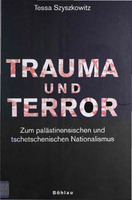Trauma und Terror
Zum palästinensischen und tschetschenischen Nationalismus
Author(s)
Szyszkowitz, Tessa
Collection
Austrian Science Fund (FWF)Language
GermanAbstract
Although small and not particularly peoples both Chechens and Palestinians became famous for suicide bomber attacks in recent years. This can - partly - be explained by the unrecognised collective traumas of the past.
Both Chechens and Palestinians experienced collective traumas in the 1940ties. The entire Chechen population wad deported by Josef Stalin to Kasakhstan, Kirgysia and Sibiria in February 1944 under the pretext of collaboration with the Third Reich. Those who survived were allowed to return in 1957 to Chechenya. Half of the Palestinian Arab population was expelled from Palestine in 1947/48, when fighting erupted between Jews and Arabs. The refugees were never allowed to return. The memory of the deportation/expulsion was kept alive. The founding traumas contributed to the development of Chechen and Palestinian nationalism. Chechens and Palestinians till today suffer from their collective traumas, which stayed unrecognised and therefore create psychological and political problems for the following generations - and for their adverseries. The phenomenon of the "closed circle of violence" created a phobic collective behaviour, which led for example Chechens to the illusionary declaration of independence in 1991. It also led to the individual overreaction of young Chechens or Palestinians, who became living bombs. The collective Trauma, if untreated, poses a threat to any peaceful political solution. 1. Einleitung
Ausgehend von der Fragestellung, warum gerade bei Tschetschenen und Palästinensern der Selbstmordterrorismus in den letzten Jahren so populär geworden ist, analysiert die Autorin die Geschichte dieser beiden Völker. Einer der Gründe ist bisher wenig beachtet worden. Der Einfluss eines kollektiven Traumas, das als solches nicht anerkannt, behandelt und auch nicht einer politischen Lösung zugeführt wurde.
2. Geschichte der Palästinenser und Tschetschenen
Im Zuge der Errichtung Israels im Unabhängigkeitskrieg 1948 verlor die Hälfte des palästinensischen Volkes - 750.000 Menschen - ihre Heimat. Unter der Führung von Jassir Arafat kämpften sie in den Jahrzehnten danach - mit Gewalt und am Verhandlungstisch - um einen eigenen Staat. Das Recht auf Rückkehr spielte dabei immer eine besondere Rolle. Die "Nakbah", die als Katastrophe empfundene Vertreibung 1948, wurde dabei Bezugs- und Angelpunkt mehrer Generationen von Flüchtlingen. Die Weigerung Israels, die Mitverantwortung für die Vertreibung der Palästinenser zu übernehmen und das kollektive Trauma der Palästinenser anzuerkennen - aus Angst vor einer Infragestellung des eigenen Staates - ist einer der Gründe, warum der Nahostkonflikt bisher nicht gelöst werden konnte.
Auch die Tschetschenen durften jahrzehntelang über die Deportation ihres Volkes nicht einmal sprechen. Hatte Josef Stallin sie erst unter dem Vorwand der Kollaboration mit Nazi-Deutschland deportiert, waren sie zwar nach seinem Tod in die Heimat zurückgekehrt, lebten dort aber jahrzehntelang weiterhin als "unzuverlässiges Volk". Das kollektive Trauma der Deportation konnte nur mündlich überliefert werden. Mit dem Zusammenbruch der Sowjetunion brach der ungelöste Konflikt zwischen Tschetschenien und Russland sofort auf, das Land ging in blutigen Kriegen unter.
3. Zusammenfassung
Die kollektive Erinnerung ist in den vergangenen Jahrzehnten zu einem zentralen Forschungsthema geworden. Der vorsichtige Einsatz von in der Individualpsychologie gewonnenen Erkenntnissen in der Behandlung von kollektiven Traumata, um zu einer politischen Lösung zu kommen, ist eine Chance.
Das Studium historischer Fakten in Kombination mit den Erkenntnissen der Psychologie und Psychiatrie bietet die Basis für eine politische Lösung. Die vorliegende Arbeit zeigt, dass kollektive Traumata, die nicht behandelt werden, immer wieder, auch Generationen später, zu kollektiven Reaktionen führen können, die auf den ersten Blick irrational erscheinen. Die vielleicht radikalste Form des politischen Widerstandes, das Selbstmordattentat, ist dafür ein Beispiel.
Keywords
Trauma; Terror; Palestinians; Suicide attacks; Recognition; ChechensDOI
10.26530/oapen_437136OCN
1030813637Publisher
BrillPublisher website
https://brill.com/Publication date and place
2007Grantor
Imprint
BöhlauClassification
History


 Download
Download